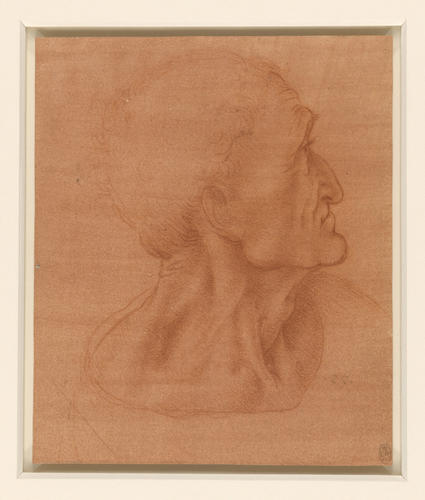-
1 of 253523 objects
The head of Judas c. 1495 or later
Red chalk on red prepared paper | 18.0 x 15.0 cm (sheet of paper) | RCIN 912547

Leonardo da Vinci (1452-1519)
The head of Judas c. 1495 or later

Leonardo da Vinci (1452-1519)
The head of Judas c. 1495 or later


-
The drawing corresponds with the head of Judas in Leonardo’s Last Supper, a mural painted for Ludovico Sforza in the refectory of Santa Maria delle Grazie in Milan, begun around 1494. This revolutionary exercise in the depiction of emotion shows the reaction of the Disciples to Christ’s announcement of his imminent betrayal. The painting was complete by 1498, but Leonardo’s experimental technique was soon deteriorating, and what we see now is a ghost of his intentions. Leonardo did not conceive of Judas as facially repulsive, but subsequent copyists of the head and later restorers of the mural exaggerated the stereotypical semitic/criminal features of Judas to an increasingly grotesque degree, hooking his nose down almost to meet his chin. The head in this drawing registers mild surprise rather than evil intent.
There are several other head studies for the Last Supper in the Royal Collection: RCIN 912552 (St James), RCIN 912551 (St Philip), and RCIN 912548 (St Bartholomew), and two accurate copies of a lost study for St Simon (RCIN 912549, 912550). The heads of Judas and St Bartholomew are carefully finished and may be definitive drawings for Leonardo to consult while working (there is no evidence that he used a full-scale cartoon for the painting), or even ‘fair copies’ by Leonardo, intended to preserve his invention for future reference. Their degree of finish has led to doubts about their authenticity, and while they are drawn with Leonardo’s usual sensitivity, the profile of Judas may have been strengthened by a later hand.
Numbered by Francesco Melzi .35.
Text adapted from M. Clayton, Leonardo da Vinci: A Life in Drawing, London, 2018Provenance
Bequeathed to Francesco Melzi; from whose heirs purchased by Pompeo Leoni, c.1582-90; Thomas Howard, 14th Earl of Arundel, by 1630; probably acquired by Charles II; Royal Collection by 1690
-
Creator(s)
Acquirer(s)
-
Medium and techniques
Red chalk on red prepared paper
Measurements
18.0 x 15.0 cm (sheet of paper)